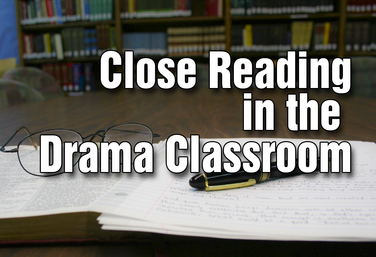Items tagged "Close Reading"
1 Course, 5 Lesson Plans, and 5 Resources tagged "Close Reading" for Drama Teachers.
Courses
Close Reading in the Drama Classroom
by Lindsay Price
Close reading is an activity that puts curriculum standards into practice and it can be easily applied to the drama classroom.
Close reading asks a lot of your students. They have to read and think at the same time.
This course teaches drama teachers how the close reading process works, and gives them exercises and tools to apply it in the classroom.
Read More...
Read Less...
Lesson Plans
Introduction to Close Reading
by Lindsay Price
Students will work on their critical thinking skills through close reading. Teachers will first model the technique with a sentence, students will practice the technique in groups and then apply their knowledge with a close reading of a monologue. This lesson comes with an individual assignment and close reading handout.
Read More...
Read Less...
Close Reading: 21st Century Issue Play
by Lindsay Price
Close reading is a text-dependent analysis tool that allows students to read a text for in-depth comprehension. Students focus on the text to understand what’s being said, how it’s being said, and why. In this lesson, students will close read a teen issue play: Censorbleep by Lindsay Price. Reading something that was written specifically for them may help students connect to the analysis process.
Read More...
Read Less...
Close Reading: Early Modern
by Lindsay Price
In this lesson, we will close read sections of an early modern text: The Importance of Being Earnest by Oscar Wilde. This play fits the criteria well for a close read text: Lots of details both in story and character, lots of structural “hows” to analyze, and Oscar Wilde makes a lot of statements with this play about Victorian England, about how people behave, about marriage, and about being truthful (earnest).
Students will approach the text through a variety of exercises, from close reading the title, to single sentences, to a small section, to a culminating assignment.
Read More...
Read Less...
Close Reading: Monologue
by Lindsay Price
Close reading is a text-dependent analysis tool that allows students to read a text for in-depth comprehension. Students focus on the text to understand what’s being said, how it’s being said, and why. In this lesson, students will use this analysis technique on a monologue. They will go through the process on a model and then apply what they have learned in a culminating activity.
Read More...
Read Less...
Close Reading: Shakespeare
by Lindsay Price
Close reading is a text-dependent analysis tool that allows students to read a text for in-depth comprehension. Students focus on the text to understand what’s being said, how it’s being said, and why. This tool can be an excellent method for getting students to connect to Shakespeare. Where students take a left turn with understanding Shakespeare is that they can’t see past the language. They can’t see using the same tools analyzing a Shakespeare play as they would a modern play. So use close reading to break the language down, move past it, and treat Shakespeare like a modern
text.
Read More...
Read Less...
Resources
Drama Teacher Tune-Up 2
Our second Drama Teacher Tune Up!
We look at including mask work in the classroom, Shakespeare, Close Reading, and Classroom Management..
Read More...
Read Less...
Attachments
Scenes for Classroom Study: Beauty and the Bee
Use this scene in your classroom for character study, scene work, substitute teachers, performance, Individual Event competitions, and however else you can imagine.
Characters: Catherine (17) and Cossett (14)
Genre: Comedy
Read More...
Read Less...
One Question and a Rubric: Close Reading
Have students demonstrate their close reading skills with these worksheets.
Read More...
Read Less...
© Copyright 2015-2024 Theatrefolk
